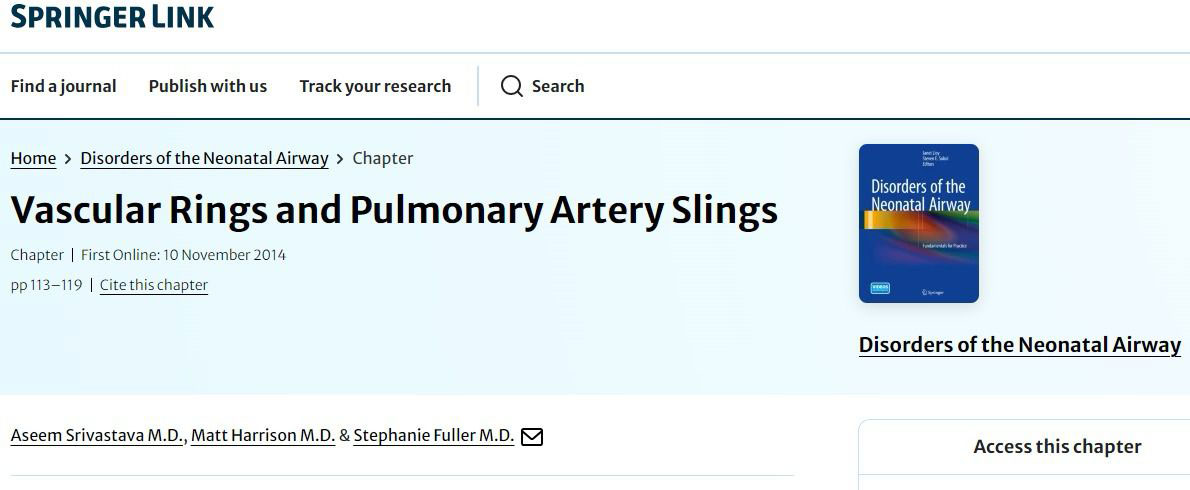What is a Vascular Ring?
Vascular Ring is a birth defect in which the great artery supplying blood to the upper body (Aorta or its branches) create a Ring around the windpipe/ food pipe or both. This will put pressure on the windpipe and/or the food pipe and many children with this defect will have serious and life-threatening breathing or feeding problems
The Left Pumping chamber of the heart (Left Ventricle) pumps red- oxygen rich blood to the body (through a tube-like Great Artery- AORTA).
The aorta will first ascend towards the neck to supply blood to the upper body (head, hands and brain) and then it will curve down (on one side of the windpipe and food pipe) to go down to supply blood to the lower body.
In children that have a vascular ring- the part of the aorta that supplies blood to the upper body, instead of remaining on one side, forms a ring-like shape around the windpipe and/or the food pipe.
This ring of aorta (or its branches) around the windpipe and food pipe puts pressure (choking) on these pipes and so babies/ children that have this birth defect will either have breathing difficulty or feeding difficulty or both. The child’s condition will depend on how tight this ring is, around the food and wind pipe.
If the ring is very tight, then the child may have life threatening problems after birth or within a few weeks after birth. For these babies, treatment of this heart condition is an emergency and may include- ventilator support, followed by surgical repair.
If the ring is not too tight at birth, then breathing/ feeding problems may appear when the child grows older.
Sometimes, the ring is not tight enough to directly cause breathing difficulty, but as the removal of mucous from the lungs is decreased by this ring- these children may have repeated pneumonia or asthma like problems.
Treatment of this heart condition is a surgery and is recommended in all babies/ children/ adults that are having symptoms from this vascular ring.
Why do the surgery?
A vascular ring that is causing breathing or feeding difficulties is a life-threatening condition and if left untreated – may cause serious harm to the child.
On the other hand- most children that undergo surgical repair will go on to live a normal life.
The surgical procedure
Surgery is recommended for all children that are having symptoms from this ring. Depending on the type of vascular ring- The surgeon will either make an incision down the left side of the chest (called a left thoracotomy) or incision down the front of the chest (called a median sternotomy) to get access to the part of Aorta (or its branches) that are forming the ring around the food/wind pipe.
The repair will consist of some of the following steps:
- Cutting and removing the part of the Vascular Ring which is not essential.
- Cutting the ring and Sewing the Aorta in its normal position.
- Dividing the PDA (or the ductal ligament)
The surgery will take an average of four to six hours from start to finish.
Risks and benefits of the surgery
Risks of surgery include bleeding, infection, longer than usual stay on the ventilator, hoarseness of voice or possibly death. However, the risk of these occurring is 2-3%.
The benefit of the surgery is that the child (once recovered) will have improved breathing and feeding, will have a normal life expectancy and quality of life.
What to expect during the hospital stay
The length of the hospital stay usually varies from 4 to 7 days, depending on how quickly the child recovers. For a few days following surgery, we will take care of your child in the ICU. In the Intensive Care Unit, we will keep a watch on the child’s Heart Rate, Blood Pressure, Respiration and other organ functions. To avoid frequent interruptions in the care of your child, there is a restriction to visitors, however, parents can visit the child.
The child may need to be in the hospital for longer if they experience any of the following:
- Fluid in the chest (pleural effusions), requiring a chest tube that is put in place at the end of surgery to stay in longer or additional chest tubes to be added
- Needing longer than usual help from a machine (ventilator) to breathe.
These challenges are part of the normal recovery after surgery in a child with a vascular ring.
After the ventilator is removed and the child is breathing on its own- he/she will be sleepy while recovering and will be under the influence of strong pain medications. It is normal for a child to be confused, thirsty, and irritable.
Going home
The hospital will supply specific discharge instructions, and all instructions from the hospital, cardiac surgeon, and cardiologist should be strictly followed. The child should get back to his or her normal routine upon arrival at home. For the first week, the child may wish to take more frequent naps or wake up occasionally at night. The child should be seen by his or her cardiac surgeon/ cardiologist within the first 3-5 days after discharge from the hospital. The incision should be kept clean and dry until it is healed.
It should also be protected from the sun for a full year. Any of the following symptoms should be reported immediately to the cardiologist:
- Fever greater than 101,
- Redness, puffiness, discharge from the incision, or
- Unusual nausea or flu-like symptoms.
For more information. healthcare providers may also: Read Here

